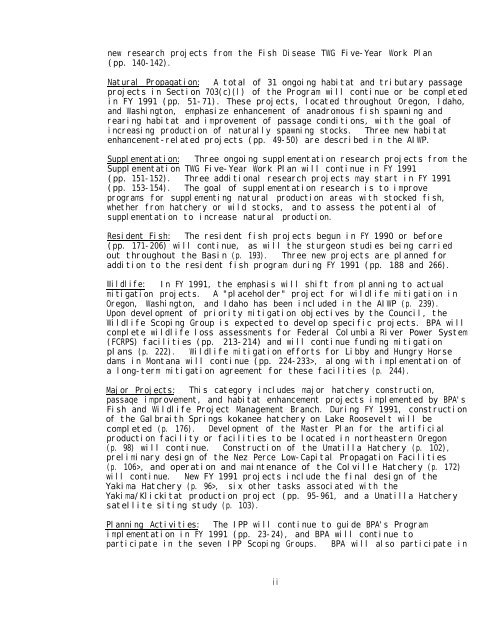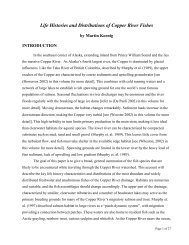columbia river basin fish and wildlife program annual ...
columbia river basin fish and wildlife program annual ...
columbia river basin fish and wildlife program annual ...
You also want an ePaper? Increase the reach of your titles
YUMPU automatically turns print PDFs into web optimized ePapers that Google loves.
new research projects from the Fish Disease TWG Five-Year Work Plan(pp. 140-142).Natural Propagation: A total of 31 ongoing habitat <strong>and</strong> tributary passageprojects in Section 703(c)(l) of the Program will continue or be completedin FY 1991 (pp. 51-71). These projects, located throughout Oregon, Idaho,<strong>and</strong> Washington, emphasize enhancement of anadromous <strong>fish</strong> spawning <strong>and</strong>rearing habitat <strong>and</strong> improvement of passage conditions, with the goal ofincreasing production of naturally spawning stocks. Three new habitatenhancement-related projects (pp. 49-50) are described in the AIWP.Supplementation: Three ongoing supplementation research projects from theSupplementation TWG Five-Year Work Plan will continue in FY 1991(pp. 151-152). Three additional research projects may start in FY 1991(pp. 153-154). The goal of supplementation research is to improve<strong>program</strong>s for supplementing natural production areas with stocked <strong>fish</strong>,whether from hatchery or wild stocks, <strong>and</strong> to assess the potential ofsupplementation to increase natural production.Resident Fish: The resident <strong>fish</strong> projects begun in FY 1990 or before(pp. 171-206) will continue, as will the sturgeon studies being carriedout throughout the Basin (p. 193). Three new projects are planned foraddition to the resident <strong>fish</strong> <strong>program</strong> during FY 1991 (pp. 188 <strong>and</strong> 266).Wildlife: In FY 1991, the emphasis will shift from planning to actualmitigation projects. A "placeholder" project for <strong>wildlife</strong> mitigation inOregon, Washington, <strong>and</strong> Idaho has been included in the AIWP (p. 239).Upon development of priority mitigation objectives by the Council, theWildlife Scoping Group is expected to develop specific projects. BPA willcomplete <strong>wildlife</strong> loss assessments for Federal Columbia River Power System(FCRPS) facilities (pp. 213-214) <strong>and</strong> will continue funding mitigationplans (p. 222). Wildlife mitigation efforts for Libby <strong>and</strong> Hungry Horsedams in Montana will continue (pp. 224-233>, along with implementation ofa long-term mitigation agreement for these facilities (p. 244).Major Projects: This category includes major hatchery construction,passaqe improvement, <strong>and</strong> habitat enhancement projects implemented by BPA'sFish <strong>and</strong> Wildlife Project Management Branch. During FY 1991, constructionof the Galbraith Springs kokanee hatchery on Lake Roosevelt will becompleted (p. 176). Development of the Master Plan for the artificialproduction facility or facilities to be located in northeastern Oregon(p. 98) will continue. Construction of the Umatilla Hatchery (p. 102),preliminary design of the Nez Perce Low-Capital Propagation Facilities(p. 106>, <strong>and</strong> operation <strong>and</strong> maintenance of the Colville Hatchery (p. 172)will continue. New FY 1991 projects include the final design of theYakima Hatchery (p. 96>, six other tasks associated with theYakima/Klickitat production project (pp. 95-961, <strong>and</strong> a Umatilla Hatcherysatellite siting study (p. 103).Planning Activities: The IPP will continue to guide BPA's Programimplementation in FY 1991 (pp. 23-24), <strong>and</strong> BPA will continue toparticipate in the seven IPP Scoping Groups. BPA will also participate inii
















